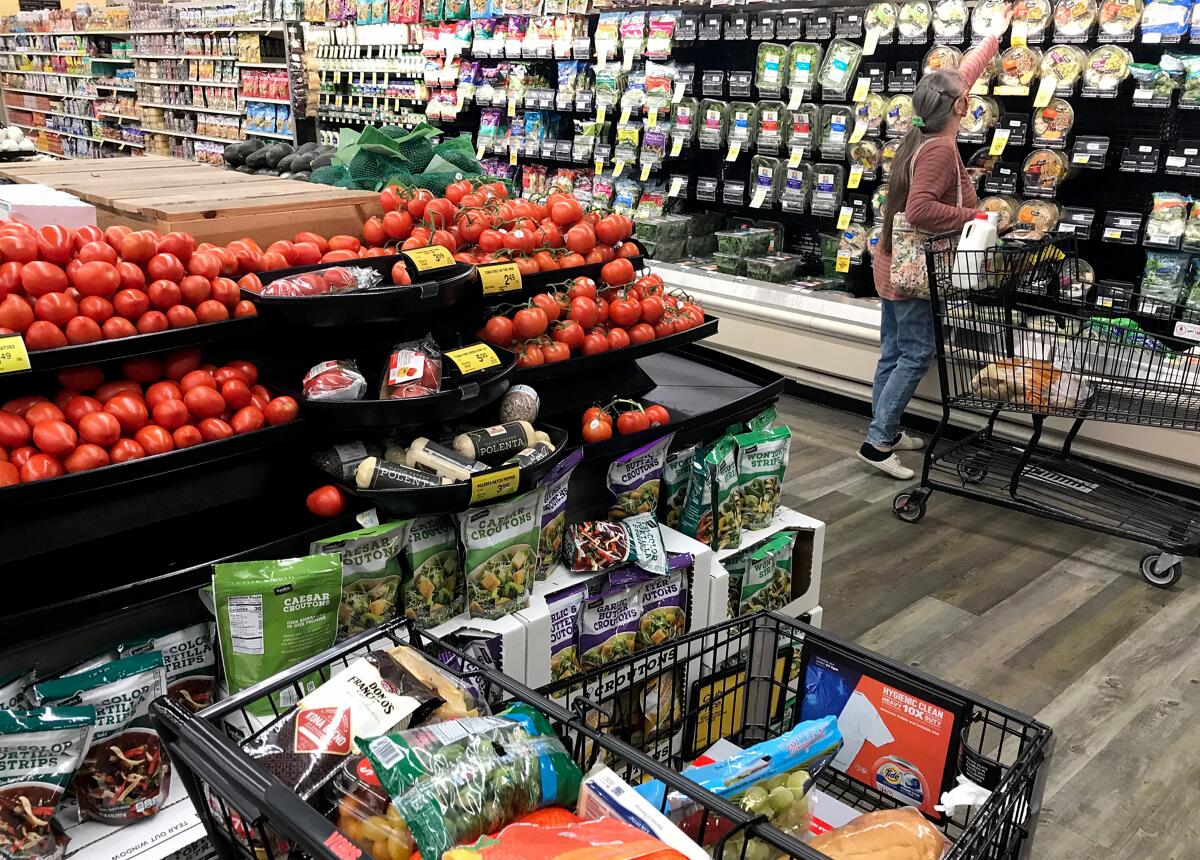With high food prices, grocery shopping has become a strategy game. Angelenos share how they get by

The U.S. is not in a recession, but the psychological weight of that possibility — combined with the effects of still-high inflation — have consumers bracing for the fallout and strategizing to save money.
Their first move? For many shoppers, it’s rethinking how they buy groceries.
Betty Luckett, a preschool owner who lives in downtown Los Angeles, has started pinching pennies at the grocery store to keep the operating costs for her business in check.
“Before I didn’t monitor the prices as much, but my budget has definitely increased over the past year,” she said. Luckett, 55, recently raised tuition to account for rising business expenses and wage increases for staff.
She shops at warehouse-style grocer Smart & Final, where she often can find what her preschool needs on sale: snacks like tangerines and animal crackers, canned vegetables, and bulk goods such as paper towels and gloves.
Ron DeSantis made his name on culture war issues. But the new presidential candidate’s healthcare record includes running one of the least-insured states in America.
Consumer packaged goods have experienced an average inflation rate of 11% over the past year, according to recent data from market analytics firm NIQ (NielsenIQ), and many shoppers have reached a breaking point. Some are switching supermarkets or eschewing brand-name products that come with a higher price tag, while others have reallocated where they spend their dollars altogether.
Zoey James, 24, a cost-conscious shopper and city government employee who lives in the Hollywood area, has cut back on some of her more expensive items, such as fresh fruit, to keep grocery costs down.
James has also started adding more rice to her meat-centered dishes. “If I make a stir fry, I use that beef for like three or four days instead of two,” she said. James buys most of her groceries at her local Trader Joe’s, which is walking distance from home, and occasionally makes a trip to Pavilions.
Consumers right now are using “a multipronged approach to try to make ends meet,” said Carman Allison, a vice president at NIQ. Allison worked on a survey tracking shopping behaviors and retail trends in the first quarter of 2023 and found that consumers “are making some discretionary tradeoffs.”
Thirty-five percent of survey respondents said they “only buy the essentials” at the grocery store, a figure up by 3 points since October. Thirty-one percent of respondents said they were buying “less expensive alternatives” to the items they typically purchase, and 38% said they “buy store-brand products” to keep costs down.
Inflation hasn’t been this high in decades. We compiled a snapshot of prices at ten grocery chains in the L.A. area. How does your local store stack up?
Allison noted that private label goods have seen a gradual uptick in popularity quarter after quarter, driven by high inflation categories such as pet care and dairy. Private label goods, or store brands, are products manufactured specifically for a retailer and sold under the retailer’s own name. Most are sold at a lower price point than a similar product from a well-known national brand.
Chedly Louis, a vice president at Moody’s Investors Service, has noted consumers increasingly buying private label goods and putting more of their purchases on credit cards. “There is a trade-down with the consumer going on,” Louis said, “because at the end of the day, you have to think about disposable income.”
Many economists project that a recession will begin later this year, while other experts (and politicians) predict that the economy will stick a soft landing.
Discount grocery stores have benefited from the current climate, which has brought in new customers at many different income levels trying to trim costs. Walmart executives said last month that grocery sales were up in the first quarter of 2023, which they credited in part to an influx of new, wealthier shoppers coming to the chain. The superstore’s first-quarter revenue was $152.3 billion, beating estimates.
Grocery Outlet, the chain known for discounting brand-name groceries, saw a similar trend in the first quarter. “Our survey data shows a higher average income customer shopping with us, which suggests that more customers are changing behaviors,” R.J. Sheedy, the company’s president and chief executive, said on an earnings call last month. “They’re looking for value.”
We asked a mix of writers, editors, chefs and staffers what supermarket they lean on most.
Not all experts, however, think these trends mean consumers are truly cutting back. “We live in an era where the narrative is constantly about declining standards of living, whereas the data continues to show ongoing real growth and consumer spending,” said Christopher Thornberg, founding partner of Los Angeles-based consulting firm Beacon Economics.
For some consumers, the strategy shift has more to do with how and where they spend their dollars. Although increased consumer spending does not necessarily result in a corresponding surge in purchases, as the impact of inflation diminishes spending power, consumers have displayed remarkable resilience. In April, retail spending in the United States rebounded after experiencing a decline for two consecutive months, despite the challenges posed by high interest rates and inflationary pressure.
“A couple years ago, goods spending was through the roof, in large part because services were all closed,” Thornberg said, referencing the early years of the COVID-19 pandemic. “Now we’re seeing a ferocious bounceback.”
That means Americans are now spending more on dining out than groceries. In April, spending at restaurants and bars was up 9.4% from 12 months earlier, according to monthly retail data from the U.S. Census Bureau. And restaurant spending is up around 40% from four years ago.
Despite traditional thinking, James says that eating out can feel nearly equal in price to cooking at home if she can split the leftovers into two or three meals. She tends to order from Asian restaurants that provide generous portions — it’s hard to split a sandwich into two meals, she says.
One of her favorite Thai restaurants is a regular on the rotation. “They give you this satay plate that’s like a mountain of rice and a bunch of chicken satay,” she said. “I’ll split it into my Tupperware containers.”
Other Southern Californians, too, are using high grocery bills to justify their takeout orders. Both takeout and grocery prices are climbing as a result of rising food and labor costs, and the former may come with a coupon or can be stretched into multiple meals.
Isabel Bello, 30, a sales and operations coordinator, said that she and her boyfriend split 50-50 between cooking and eating out. Uber Eats has recently sent her several promotions, sometimes offering up to 40% off an order, which feels like a steal in the current economic climate.
When she does go grocery shopping, she goes to multiple stores to assemble a week’s worth of food — Ralphs or Walmart for produce and Hawaii Supermarket or H Mart for her Asian groceries.
“[Ralphs] just has more of the veggies that I’m looking for,” Bello said while picking out asparagus with her boyfriend at a location in downtown L.A.
Even though preschool owner Luckett has felt the pain of rising prices at the checkout counter, when it comes to her own shopping, she’s trying to hold out as long as possible before taking major cost-cutting measures. She and her husband, who is vegan, mostly cook at home — one dinner last week was black-eyed peas with rice and fresh string beans. They eat out once a week, typically at a sit-down restaurant.
The health-conscious couple primarily shop at Whole Foods for groceries, since Smart & Final does not offer the organic fruits and vegetables they want.
“We pay easily between $100 and $120 a week,” she said of her grocery budget. “I can’t imagine what it’s like to feed a family of four.”











